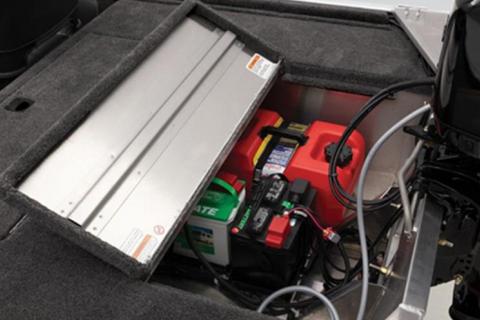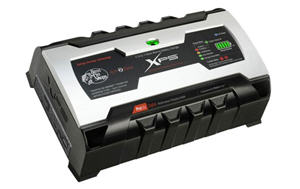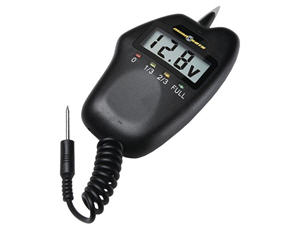
 |
| On-board boat chargers like the Bass Pro Shops XPS IT2 4/4 Onboard Battery Charger are technologically advanced, providing multi-stage switching to manage and maintain a boat's batteries during the charging process. |
One of the most crucial concerns of boat battery performance is the method and extent to which the batteries are charged after being depleted to acceptable levels. An overcharged battery will shed material from its plates and boil away its electrolyte, dooming it to a short, ineffective life. The plates of an undercharged battery will get clogged with lead sulfite, requiring you to carry that battery to the recycling center early as well. Using the right marine battery charger can help you avoid these problems.
Marine Batteries Respond to Charging Differently
Wet-cell, gel and AGM batteries respond to charging in different ways and are very particular in the way their electrons are reenergized. Batteries must be recharged just so. If you fail to do it correctly, you'll be forced to purchase a new boat battery. For this reason, an important first step in buying a charger is to read all pertinent information provided by the manufacturer to determine that the one you purchase will be compatible with the type or types of battery you'll be charging.
You also should determine what size battery charger is right for your boat. Begin by considering the number of batteries on your boat. Chargers are offered in one-, two-, three- and four-bank (battery) configurations.
 |
| Minn Kota Battery Meter |
Charging time also should be considered. If you have 12 hours or more between trips, you may be happy with a lower-amp charger. If faster charging is needed, a more powerful unit (10 amps and above) may be best.
Additionally, you should consider the number of engines on your boat. If you have one engine, you'll only need a charger with a single cranking-battery output. Twin-engine applications, however, call for a charger with dual cranking-battery outputs.
Portable vs On-Board Boat Chargers
If you own a smaller boat and can easily remove the battery from your craft to charge it, a portable charger may be a good choice. Portables also are great when you need to charge batteries on several boats.
 |
| Minn Kota MK 110PD Portable Digital Battery Charger |
These units vary widely. Some are hardly bigger than a computer mouse. Others are the size of a small suitcase. The old-fashioned "trickle chargers" most of us are familiar with fall into this category. But state-of-the-art models like the Minn Kota Model MK110P Battery Charger with short circuit/reverse polarity protection and LED displays also are available.
Portable battery chargers are connected to batteries using alligator clips or a harness attached to the battery posts. The best models are encapsulated with seal-tight materials that protect the unit from shock, vibration and moisture. Good chargers also have automated charge sensors that detect the battery's voltage level to assure an optimum charge.
 |
| Portable boat amp chargers are great for those who need to charge batteries on several boats. |
The primary disadvantage of portable chargers is the fact they can be inconvenient to hook up and switch from battery to battery in the confines of a boat's battery compartment. And because they are portable, they are subject to being stolen if you must use them in a motel parking lot, boat stall or other public place.
Owners of bass boats and larger crafts are probably better served by purchasing an on-board battery charger like Bass Pro Shops XPS IT2 4/4 OnBoard Battery Chargers or one from the NOCO, Marinco, Minn Kota or ProMariner lines. On-boards tend to be more expensive than portables, but they easily pay for themselves in convenience. When you return home from a boating trip, you simply plug the charger into a 120-volt outlet and let the charger maintain your batteries without the hassle of personal monitoring. An onboard charger is always hooked up and is only a plug-in away from charging your batteries. Because it's permanently installed, it's more difficult for thieves to make off with. And most importantly, on-board chargers are more technologically advanced units, providing multi-stage switching to manage and maintain a boat's batteries during the charging process.
Linear vs Multistage Battery Chargers
On-board boat chargers can be loosely lumped into two categories: linear chargers and multistage electronic chargers.
 |
| Minn Kota Digital Linear Onboard Battery Charger - MK-330D |
While linear chargers remain widely available, they are falling into disfavor with many boaters because, by nature, they tend to negatively affect battery life and performance. This is because the unit shuts off when the battery is fully charged and doesn't begin charging again until the battery drops below 90 percent capacity. "Cycling" batteries this way as opposed to "maintaining" the charge tends to reduce battery life. Additionally, linear models often are set at voltages too high for maintaining batteries. This results in overcharging, which can boil the electrolytes dry in wet-cell and AGM batteries and harm gel batteries as well.
A linear charger's strengths are in its simplicity and heat-reducing, vented design. While slightly bulkier, linear chargers do not let out the heat of multistage chargers. Linear chargers typically are water-resistant, not waterproof, however, and should be installed in a watertight area of a boat.
Chargers with multistage electronic technology, often called "smart chargers," charge batteries in different phases. By controlling the charging output in various steps, this technology significantly reduces charge time. And when batteries are fully charged, the unit automatically drops to a maintenance mode that holds the batteries at a 95 to 100 percent charge. This eliminates the cycling and potential overcharging often associated with linear chargers.
Multistage electronic chargers can efficiently service both cranking batteries and deep-cycle batteries. Most are fully waterproof as well, making them great choices for installation in bilges and non-watertight compartments when other space is at a premium.
Regardless of the type you choose, once installed, the charger is ready to be plugged in and do its job. Read over the instructions included with your charger to familiarize yourself with proper installation and use. Then enjoy your time on the water as much as possible. With a portable or on-board charger, your time in the boat will be spent having fun, confidently knowing your batteries are charged and ready to get you going and keep you going.
- 32675 views

